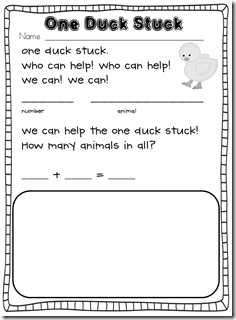Have you ever read this book, "One Duck Stuck"? When a duck is stuck, who will help? Several pond friends take turns trying to help free the duck, who is stuck in the muck. The duck is progressively helped by two fish, three moose, four crickets, five frogs… up to ten dragonflies, and soon, with assorted noises and actions, the duck finally becomes unstuck.
For a read-aloud it's great because you can teach children the phrase from the book, “Help! Help! Who can help?” so they can say it in a choral group before you turn each page.
Oceans of 1st Grade Fun has a great blog post about using this book and some worksheets she created to work on the addition fact of +1.

Be sure to link over there by clicking on the name of the blog and check out all her great ideas.
My own idea relates to "HOW MANY ANIMALS IN ALL tried to help the stuck duck." First, assign a different animal to 10 groups of children. Using base ten block manipulatives, each group obtains one unit block for each animal on their assigned page that tries to help the duck. Then the group meets in whole group. In numerical 1-10 order, each group gives their blocks to the teacher who then adds their block(s) onto the top of the whole groups' labeled 100's block.
Trade 10 unit blocks for one ten whenever possible. Then when all groups have contributed their individual unit blocks, the total amount is there for everyone to see. I like it because it involves trading 10 ones for 1 ten, and it is a concrete visual picture of adding to "find how many in all."

Oceans of First Grade Fun worksheet could then be used to write out or "draw" their thinking about how many animals helped the duck.
Deborah




 Oceans of First Grade Fun worksheet could then be used to write out or "draw" their thinking about how many animals helped the duck.
Oceans of First Grade Fun worksheet could then be used to write out or "draw" their thinking about how many animals helped the duck.


